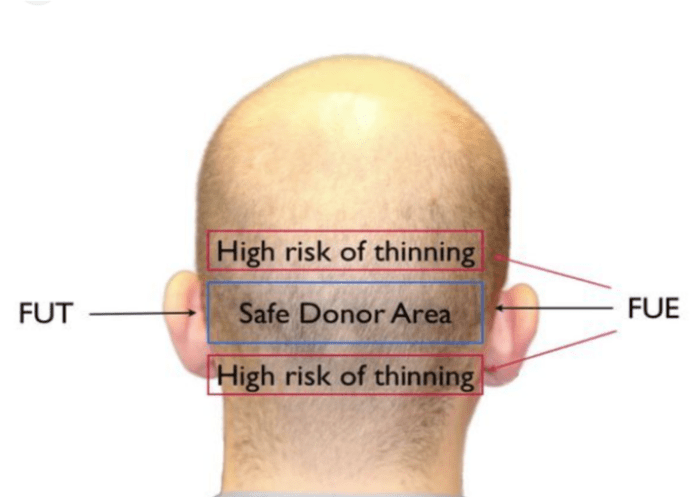When More Isn’t Better: The Consequences of Overharvesting Donor Hair in Hair Transplants
Hair transplantation is an evolving field of science, medicine, and artistry. It is an aesthetic procedure that requires short and long-term hair loss management strategies and most importantly a well-thought-out surgical plan with an experienced surgeon who understands that every patient has a finite amount of donor hair to be utilized for hair restoration procedures. That’s why we call it, your precious donor hair. The overall surgical plan is based on multiple factors:
• The quantity and quality of the available donor hair
• The amount of hair loss
• The age and gender of the patient
• The patient’s preferred hairstyle
• The patient’s scalp coverage and hair density goals
• The patient’s areas of concern
Once these basic elements are determined, the all-important artistic plan of the hair transplant is developed with your surgeon assessing how much donor hair may be safely harvested and how to create recipient sites in the balding and thinning areas to create the allusion of the most hair.
Overharvesting in the realm of hair transplantation is a phenomenon that warrants careful consideration, as it pertains to the sustainable use of the donor zone – the limited area on the back and side of the scalp recognized as the “safe donor zone” and the finite amount of the actual donor hair. The safe donor zone is essentially the region on the scalp where the hair follicles are genetically resistant to the effects of DHT which causes hair miniaturization and ultimate pattern hair loss. It is the primary source for donor hair grafts in both Follicular Unit Excision and Extraction (FUE) and Microscopically Dissected Elliptical Excision (MDEE) hair transplant procedures. However, not all hair within this zone is created equal, and careful assessment must be given to balance between extraction and preservation.

In FUE surgery, the individual extraction of follicular units is the norm. While FUE is generally regarded as less invasive than MDEE, it does leave tiny pinpoint scars and it still demands careful planning to avoid overharvesting. Your hair transplant surgeon must assess the density of the follicles and their distribution to determine the maximum number that can be safely harvested in a single surgery session. Because you must shave the back and sides of the head for FUE procedures, most women are not keen to have this type of hair surgery. Additionally, hair transplant surgeons do not typically recommend FUE for their female patients because the physical size of a woman’s head tends to be smaller than their male counterparts and their donor hair is less dense, making them more prone to visible overharvesting.
Comparatively, MDEE surgery involves the removal of a strip of scalp tissue from the safe donor zone, which is then dissected into the hair grafts for transplantation. The key difference lies in the method of extraction. MDEE, by nature, involves a linear incision and stitches to close the wound. The potential for overharvesting is lower than in FUE, but the resulting linear scar may be a concern for some patients even though it is nearly invisible.
Donor hair overharvesting is problematic due to its potential to deplete the safe donor zone, leading to a reduction in the overall hair density in this area which may expose scaring or create the appearance of patchy hair loss. This compromises the aesthetic outcome of the hair transplant but also limits future transplant options for patients –particularly those patients who may need a second surgery to achieve the hair density goals. The safe donor zone, once overharvested, may not recover fully, and the long-term impact is irreversible.
The consequences of overharvesting extend beyond the immediate visual aspects of the hair transplant results. Patients who have had excessive harvesting may experience chronic donor site pain, diminished blood supply to the scalp, and an increased risk of infection. Additionally, the depletion of the donor zone limits the ability to address progressive hair loss seen in Androgenic Alopecia, which is the most common cause of hair loss in men and women. This is especially concerning for younger patients who may require multiple procedures over their lifetime to address ongoing hair loss.
Choosing an experienced and ethical surgeon is paramount in preventing overharvesting of the donor zone. Ziering surgeons are known for their precision in assessing a patient’s donor hair, taking into account available donor hair, follicular unit distribution, hair density, donor hair quality and personality, and future hair loss projections. By adopting a conservative approach to harvesting and respecting the limits of the safe donor zone, surgeons can ensure the long-term viability of hair restoration for the patients along with making the best use of the finite donor hair available.
Overharvesting during a hair transplant procedure poses significant risks to both the immediate and long-term outcomes of the procedure. Understanding the safe donor zone, the differences between FUE and MDEE, and the potential consequence of donor hair overharvesting is crucial for patients.
The primary goal of every Ziering Medical surgeon is to design and deliver a natural, undetectable hair transplant result, safely managing and maximizing your precious donor hair for successful and sustainable results.
